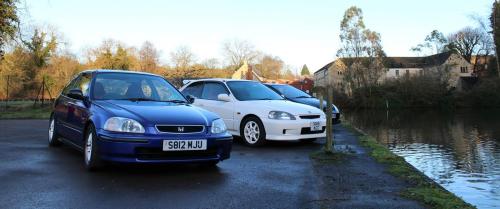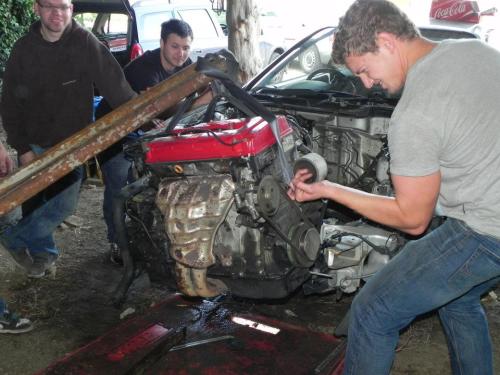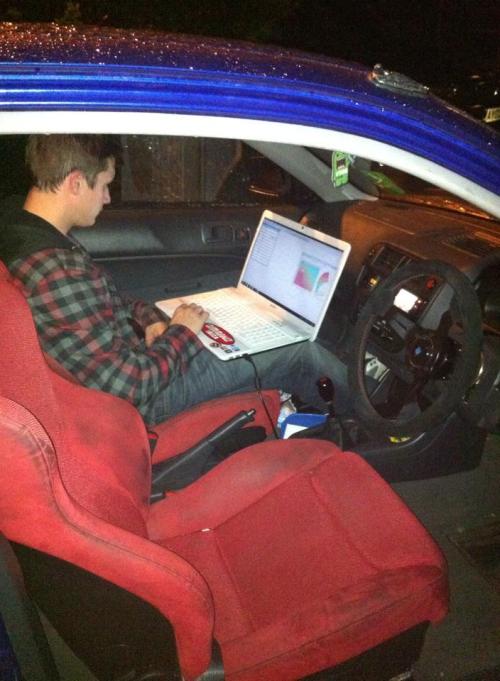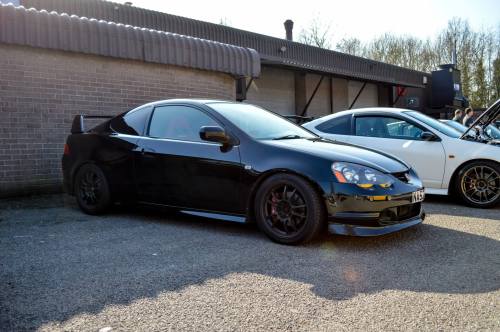By Nathan Green
Power. We love, it don’t we? For many petrol heads, extracting as much horsepower as possible from the internal combustion engines bolted into our cars can easily become an obsession.
I know from experience that nothing puts a bigger smile on our faces than the stomach churning acceleration provided by a high-output engine in a featherweight chassis.
Those days are unfortunately a distant memory for me. My 240bhp, 2.0 16v, turbocharged Vauxhall Corsa died years ago, and, after some difficulties, my Renault Clio 172 Cup had to go.
Luckily for me, my younger brother, Liam, and many of his closest friends, drive Hondas. VTEC Hondas. The ones you want.
Liam owns a late nineties, Honda Civic EK ‘Illusion’ hatchback. Originally a base spec 1.4 variant, now fitted with a B18C4 engine (1.8 16v VTEC petrol engine) from a Honda Civic Aerodeck (Civic estate) which plays host to a decent list of thoughtfully planned and executed power augmenting modifications.
The little terror has also fitted Recaro bucket seats from a Type R of some sort, a set of rare alloy wheels that Honda people lust after and a tasty set of coilovers to give it the necessary Honda stance. The boy’s done good.
He also has a Mazda RX7 FD and, until recently, owned 300bhp+ Toyota Starlet EP82 GT fitted with the biggest, shiniest turbocharger I ever did see. He also has a lovely, approving girlfriend. Lucky son of a gun.
Anyway, I digress. The aforementioned modifications have increased the brake horsepower of the engine in Liam’s Civic to approximately 200 at the flywheel. Maybe more.
So, with the car only weighing around 850kg, the first time I went in it, and bro hit VTEC in first and second gear, I didn’t know if I was going to shit myself or ejaculate.
Let me try to explain. Being in something VTEC powered, is, unlike any other experience I’ve had in a car, even a modern sports car, in fact most Supercars can’t match it for thrills. There’s just something so guttural and raw about the way a VTEC engined car accelerates, especially a lightweight model with an early B16 or B18 engine.
You can feel the VTEC system switch to the higher lift cam- you can feel it at your fingertips on the steering wheel and through your toes on the pedals. You can feel it in your heart, your soul. It reverberates through you as the engine accelerates rapidly towards the rev limiter, set at some crazy level above 8,000rpm.
You don’t feel insulated from the power like you do in some cars, you feel excited by it, enclosed in it, wrapped inside of it. It becomes you and you become it, combined as one by a common love for thrusting forward motion and darting changes in lateral acceleration and deceleration. It sounds a bit like sex, I know, even stranger, it almost feels it.
Words alone cannot bring justice to the experience of being inside a Honda as the whaling, high-pitch sounds and associated vibrations of a VTEC engine are revealed during and after switching to its more aggressive camshaft profile.
It is an experience you must enjoy for yourself to fully understand. If feel you have no way of making this happen, just ask. I’ll make it happen, somehow, some way.
So, where did it all begin, this ‘Variable Valve Timing and Lift Electronic Control’ malarkey?
Allow me, if you will, to take you back to the 1980’s. Turbocharger technology had become the main focus for many mainstream car manufacturers across the globe with regards to increasing engine power output and, in some cases, fuel efficiency.
Honda had a different idea. Their aim was to increase the volumetric efficiency of the internal combustion engine by use of variable valve technology. They embarked on the task of building a reliable engine that could produce 100hp per litre of engine displacement without using forced induction. This was a goal that, at the time, seemed faintly ridiculous and possibly, unachievable.
Regardless, Ikuo Kajitan, the man tasked with making this dream a reality, cracked on and invited a team of engineers to join him. Once the scale of the project became clear, he is said to have invited them to leave if they wished. Testament to just how hugely dedicated a task he was asking them to complete.
Kajitan had been heavily involved in Honda’s New Concept Engine, or NCE, development program in the early 80’s and had recently finished this project, extracting 130bhp from a DOHC 1600cc engine for which he was highly praised.
However, the overwhelming task of mastering the first Honda VTEC engine and achieving 160bhp from an engine with the same cubic displacement, would see him become one of the true unsung heroes of motor vehicle design and engineering. Ever.
Ever ever ever.
Ever.(1)
After a long battle of making lighter materials stronger and trying to effectively protect them against the immense rotational, frictional and thermal forces at work inside of a confined space the size of four small milk bottles while hundreds of pieces of metal work against each other’s surfaces at up to 9,500rpm for years on end over hundreds of thousands miles……..they did it. And they did it in perfect style with absolutely, for the time, unequalled precision.
The first VTEC powered car was the Honda Integra XSi, released to the Japanese Domestic Market (JDM y’aaalll!) in 1989. This car was powered by the now famous 160bhp 1.6 litre B16A engine and instantly became a huge hit.
Amazingly the later B18C engine which powered the 1995-onward JDM Integra DC2 model produced an incredible 197bhp. That’s almost 110bhp per litre. With no turbocharger!
The first VTEC Honda to be sold in the European market was the CRX 1.6i-VT with a slightly detuned 150bhp version of the B16A engine. Don’t let the 10bhp deficit fool you. These are still very capable cars, both in a straight line and through the twisties. I remember ‘racing’ a blue one down a long dual-carriageway in 2.0 16v Redtop engined Vauxhall Corsa. It made me feel very surprised and look really rather silly as it approached from behind, reeled me in, chewed me up, spat me out and disappeared into the horizon.
Nowadays, thanks to the countless hours dedicated by many people to develop Honda’s original VTEC system and the time since spent developing abundant associated performance parts and accessories, my brother can sit in his ’99 Honda Civic, on the driveway, plug my laptop into the engine’s ECU and play with the VTEC’s timing, fuel and ignition graphs, view sensory information and even diagnose faults with relative ease.
He can even send the information to his iPhone via Bluetooth. I bet Ikuo Kajitan didn’t envision Liam Green doing that to his system, 25 years after he created it. I bet he didn’t envision me spending the last 2 hours trying say his name properly either. Damn it.
VTEC engines are like your best friends- they are consistently dependable. They can be reserved and efficient when you need them to be and yet be absolutely insane, outlandishly good fun and provide countless smiles when you want them to.
The system is a huge credit to Honda who, despite the immense challenge and, initially, extremely daunting task of building a reliable, high-revving, high-output, mainstream engine, have actually managed to over-engineer their VTEC units to a point whereby they uphold a reputation for being almost indestructible.
This, I think, deserves the highest level of commendation. For me, the invention of VTEC is an absolutely stunning example of how, with appropriately thorough research, painstaking attention to detail and bloody hard work, as a race, human beings can achieve some truly amazing things.
Thank you Honda and, as always, thank you all for reading.
1. I won’t go into the finer details of how the VTEC system works because, if you’re a Honda lover you will already know and, if you’re not, you probably won’t care too much. However, for those of you who don’t understand how the magic behind VTEC works but would like to, I promise I will write a piece explaining it all for you.
In fact, it’s already in the pipeline. For now, search ‘how does VTEC work’ on YouTube, pick a video and stare at the screen in amazement at the feast of fine timing, it should offer you some food for thought.







Pingback: Interesting read about honda VTEC engines - EK9.org JDM EK9 Honda Civic Type R Forum
GOH!? Oh dear someones trying to get her in bed! Cringe.
Wouldnt say shes that either to be fair